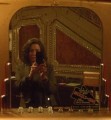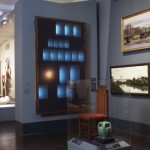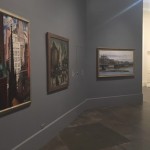Before and After: ASKing about American Art
This month marks one year since the reinstallation of the Museum’s fifth-floor American art galleries, formerly known as “American Identities: A New Look.” This anniversary made us wonder how ASK chats have changed since these galleries were reorganized. I took a look back at some older and more recent chat histories and I noticed a few shifts in engagement.
Before last April, chats in the American art galleries tended to cluster around a few key artworks. Any of the ASK team members could have recited a list of the most “frequently asked about” works: Albert Bierstadt’s A Storm in the Rocky Mountains, Mt. Rosalie and the adjacent contemporary painting, Valerie Hegarty’s Fallen Bierstadt; Gilbert Stuart’s full-length portrait of George Washington; Francis Guy’s Winter Scene in Brooklyn; John Koch’s The Sculptor; and Aaron Gilbert’s The New One.
Sara recently blogged about ASK gallery labels and their ability to spark app usership, and some of those objects were indeed labeled with ASK prompts: the Bierstadt and the Koch, for example. And as I discussed in my own recent post, large works often catch ASK users’ eyes. Bierstadt’s spectacular landscape is large, and so is Francis Guy’s quieter Brooklyn view.
Koch’s The Sculptor is not only a large-scale canvas, it also features a nude male figure and an enigmatic narrative. Aaron Gilbert’s The New One isn’t particularly imposing in size, nor did it have an ASK label, but its slightly surreal imagery consistently raised questions in visitors’ minds.
Last April, the overall number of paintings and sculptures in the American art galleries was pared down, so that works are given more room to “breathe,” and the galleries were painted off-white or a single, muted color rather than combinations of colors. Various decorative elements and multimedia interpretive materials were also removed.
These changes have affected our app traffic for certain objects. For example, an Edward Hopper cityscape titled Macomb’s Dam Bridge that was previously hung above two other works in an alcove-like space (left image) is now installed at eye level (right image). We rarely received any questions about it before April 2016, but now it appears in chats more regularly.
In fact, the ASK team used to say amongst themselves that visitors just didn’t have any questions about still lifes and quiet landscapes, but this theory no longer holds. Our beautiful examples of mid-1800s still life painting used to hang on an angled freestanding wall in a dark area. Now that they’re installed on a longer wall with a lighter paint color and better lighting, they’re frequent subjects of app chats. Were they just overlooked in their previous location?

The Luminist landscapes (top row before and after) and still lifes (bottom row, before and after) now get a chance to shine.
The same thing happened with a grouping of nineteenth-century Luminist landscapes. They used to hang in a small gallery with multiple wall colors, next to a doorway that offered a sight line to the Bierstadt landscape. No one ever asked about these tranquil small-scale landscapes before, but now they regularly appear in app chats. Are they easier to spot now that they’re no longer competing with Mt. Rosalie? One of them, Francis Silva’s The Hudson at the Tappan Zee, also has an ASK label, which probably boosts interest for that particular painting.
Speaking of competition, we have a hunch that the absence of video monitors and sound effects in the galleries also gives more visitors more mental space to focus on smaller or less dramatic works and to use the app. There are just fewer sensory attractions—or distractions, depending on your point of view.
And what about old favorites The Sculptor and The New One? Well, The New One is currently off view, but The Sculptor is hanging in our restaurant, The Norm, where people frequently ask to be seated near it. So it’s still popular in its new context; some things never change!

Jessica Murphy, Manager of Visitor Engagement, joined the Brooklyn Museum in 2015 as a member of the ASK team. In her current position she leads the team in their interactions with the Museum’s visitors through the ASK app and coordinates their ongoing training and development. Jessica received her B.A. from Fordham University and her M.A. and Ph.D. in Art History (with a concentration in American Art) from the University of Delaware. She previously worked as Research Associate at the Metropolitan Museum of Art (contributing to exhibitions and publication such as “Alfred Stieglitz and His Artists: Matisse to O’Keeffe” and “The American West in Bronze”), as Contractual Educator at the Met, and as Curatorial Assistant at the Philadelphia Museum of Art. She has also worked as a freelance writer on cultural topics. She welcomes any opportunity, in any medium, to connect people and art.




maria teresa tavares - 7 years ago
Hi, I am a student of the Master of Arts and Cultural Management at the University of Melbourne and I am really interested in the ASK project. Would you please clarify one doubt I have? Was the rearrangement of the American art galleries an independent process? Or was it done together with the ASK team? Since the App can provide so much information on visitor’s behaviour, I was wondering if the information collected by the ASK team could have informed some of the decisions to the rearrangement itself.
Thank you so much,
Maria Teresa
Sara Devine - 7 years ago
Hi Maria Teresa,
We shared the information, the questions and answers from ASK, with the curators, who used that information at their own discretion. In some cases it did inform certain decisions. For example, our assistant curator of American art at the time noticed people weren’t making connections between works on view intended to be understood together and updated the layout and label copy to try to better emphasize groupings to make that clearer. I hope that helps.
Best,
Sara